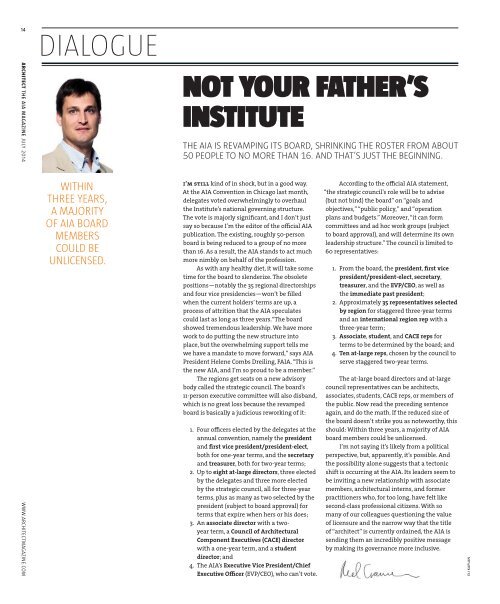Architect 2014-07.pdf
You also want an ePaper? Increase the reach of your titles
YUMPU automatically turns print PDFs into web optimized ePapers that Google loves.
14<br />
DIALOGUE<br />
ARCHITECT THE AIA MAGAZINE JULY <strong>2014</strong> WWW.ARCHITECTMAGAZINE.COM<br />
WITHIN<br />
THREE YEARS,<br />
A MAJORITY<br />
OF AIA BOARD<br />
MEMBERS<br />
COULD BE<br />
UNLICENSED.<br />
NOT YOUR FATHER’S<br />
INSTITUTE<br />
THE AIA IS REVAMPING ITS BOARD, SHRINKING THE ROSTER FROM ABOUT<br />
50 PEOPLE TO NO MORE THAN 16. AND THAT’S JUST THE BEGINNING.<br />
I’M STILL kind of in shock, but in a good way.<br />
At the AIA Convention in Chicago last month,<br />
delegates voted overwhelmingly to overhaul<br />
the Institute’s national governing structure.<br />
The vote is majorly significant, and I don’t just<br />
say so because I’m the editor of the official AIA<br />
publication. The existing, roughly 50-person<br />
board is being reduced to a group of no more<br />
than 16. As a result, the AIA stands to act much<br />
more nimbly on behalf of the profession.<br />
As with any healthy diet, it will take some<br />
time for the board to slenderize. The obsolete<br />
positions—notably the 35 regional directorships<br />
and four vice presidencies—won’t be filled<br />
when the current holders’ terms are up, a<br />
process of attrition that the AIA speculates<br />
could last as long as three years.“The board<br />
showed tremendous leadership. We have more<br />
work to do putting the new structure into<br />
place, but the overwhelming support tells me<br />
we have a mandate to move forward,” says AIA<br />
President Helene Combs Dreiling, FAIA. “This is<br />
the new AIA, and I’m so proud to be a member.”<br />
The regions get seats on a new advisory<br />
body called the strategic council. The board’s<br />
11-person executive committee will also disband,<br />
which is no great loss because the revamped<br />
board is basically a judicious reworking of it:<br />
1. Four officers elected by the delegates at the<br />
annual convention, namely the president<br />
and first vice president/president-elect,<br />
both for one-year terms, and the secretary<br />
and treasurer, both for two-year terms;<br />
2. Up to eight at-large directors, three elected<br />
by the delegates and three more elected<br />
by the strategic council, all for three-year<br />
terms, plus as many as two selected by the<br />
president (subject to board approval) for<br />
terms that expire when hers or his does;<br />
3. An associate director with a twoyear<br />
term, a Council of <strong>Architect</strong>ural<br />
Component Executives (CACE) director<br />
with a one-year term, and a student<br />
director; and<br />
4. The AIA’s Executive Vice President/Chief<br />
Executive Officer (EVP/CEO), who can’t vote.<br />
According to the official AIA statement,<br />
“the strategic council’s role will be to advise<br />
(but not bind) the board” on “goals and<br />
objectives,” “public policy,” and “operation<br />
plans and budgets.” Moreover, “it can form<br />
committees and ad hoc work groups (subject<br />
to board approval), and will determine its own<br />
leadership structure.” The council is limited to<br />
60 representatives:<br />
1. From the board, the president, first vice<br />
president/president-elect, secretary,<br />
treasurer, and the EVP/CEO, as well as<br />
the immediate past president;<br />
2. Approximately 35 representatives selected<br />
by region for staggered three-year terms<br />
and an international region rep with a<br />
three-year term;<br />
3. Associate, student, and CACE reps for<br />
terms to be determined by the board; and<br />
4. Ten at-large reps, chosen by the council to<br />
serve staggered two-year terms.<br />
The at-large board directors and at-large<br />
council representatives can be architects,<br />
associates, students, CACE reps, or members of<br />
the public. Now read the preceding sentence<br />
again, and do the math. If the reduced size of<br />
the board doesn’t strike you as noteworthy, this<br />
should: Within three years, a majority of AIA<br />
board members could be unlicensed.<br />
I’m not saying it’s likely from a political<br />
perspective, but, apparently, it’s possible. And<br />
the possibility alone suggests that a tectonic<br />
shift is occurring at the AIA. Its leaders seem to<br />
be inviting a new relationship with associate<br />
members, architectural interns, and former<br />
practitioners who, for too long, have felt like<br />
second-class professional citizens. With so<br />
many of our colleagues questioning the value<br />
of licensure and the narrow way that the title<br />
of “architect” is currently ordained, the AIA is<br />
sending them an incredibly positive message<br />
by making its governance more inclusive.<br />
ELI KAPLAN


















